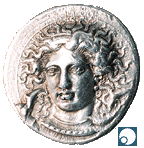

I first saw the coins in the Ottilia Buerger Collection arrayed on a countertop
beneath a kitchen window overlooking the Rock River in Mayville, Wisconsin,
in 1983. Each coin was sheathed in a plastic holder and marked with identifying
notations. And each was clearly an object of joy, satisfaction, and instruction
to the woman who had acquired it. Little did either Miss Buerger or I imagine
at that, our first meeting, that ten years later the collection would come
to Lawrence and become the focus of this exhibition. But so too, little
did Miss Buerger imagine that what started out as the purchase of a single
Roman coin in the late 1950s would turn into a collection of remarkable
range and import.
Ottilia Buerger graduated from Lawrence with a major in Latin in 1938
magna cum laude and as a member of Phi Beta Kappa and Eta Sigma Phi.
Following her graduation, she taught Latin and English for the next several
years at the high schools in Goodman, Wautoma, and Beaver Dam, Wisconsin,
before returning home to her native Mayville to care for her ailing mother.
The love of the language, culture, and history of the classical world that
Miss Buerger nurtured and enriched as an undergraduate at Lawrence continued
to be one of her central intellectual interests in her years in Mayville,
though it was not until 1958 that she extended that interest to embrace
numismatics. At that time, Gimbels Department Store in Milwaukee had a small
coin shop on the premises, and it was there that Miss Buerger made her first
acquisition: she purchased a Roman denarius for "about $5.00."
She made the purchase with the vague notion that she might buy other ancient
coins, but not with any intention to build a collection. Over the next several
years, by her recollection, she bought about two dozen more coins from Gimbels
and also began purchasing items from Edward Gans, a dealer from Berkeley,
California.
Acquiring and admiring these objects brought her pleasure, and by the mid-1960s
she had decided to begin to collect in a more serious and systematic fashion.
She was influenced in this decision by a visit to the collection of ancient
coins at the Smithsonian in Washington and by reading the catalogue of the
Greek and Roman coins in the J. Pierpont Morgan Collection; indeed, she
determined to pattern her collecting after Morgan's and to build a collection
that would rival his in its holdings of Roman aurei. Specifically, Miss
Buerger set out to acquire gold coins from the reigns of all legitimate
emperors of ancient Rome.
At this point, trips to Gimbels no longer would serve, and she branched
out by contacting major coin dealers throughout the United States as well
as in Great Britain and Switzerland. In addition to her acquisitions from
Edward Gans, she also corresponded with Seaby's and Spink and Son of London,
Coin Galleries of New York, Bank Leu of Zurich, Münzen and Medaillen
of Basel, and Harlan Berk of Chicago, through whom she submitted mail bids
for coins at major international auctions. In the process, she acquired
coins from distinguished private collections and from the dispersal of the
collections of such major public institutions as the Metropolitan Museum
of Art and the Santa Barbara Museum of Art. Nearly all the coins bring real
meaning to the term "mint condition," and some are so rare that
only two or three other examples are known.
So what began, in her words, as a "harmless hobby" has become
"a significant life's accomplishment." Lawrence is privileged
to be steward and sharer of that accomplishment for the benefit of our students
and others who will be enriched and enlightened by this collection. The
collection--as it is and as it appears in this exhibition--is quite remarkable
in its scope and quality. For the past several years, Lawrence students
under the direction of Professor Carol Lawton have been studying these coins
in preparation for this exhibition and the publication of this catalogue.
These objects of aesthetic beauty and historical significance have served
as stimulating opportunities for student learning in art history, classical
studies, and history. The fruits of that learning are contained in the catalogue
entries on the following pages.
And that is what Miss Buerger intended when she decided to share her collection
with Lawrence and its students and with us all, a decision she reached with
the encouragement of her brother Peter, who gave the idea his full support
several years ago. With the completion of the Wriston Art Center, her determination
to give the coins to Lawrence strengthened. Miss Buerger's words at the
small ceremony dedicating the collection here in 1991 speak volumes about
the nature of this college, the meaning of this gift, and the convictions
of this most generous alumna: "Now I am returning to my alma mater
what she has so richly endowed me with--a love of truth and beauty beyond
price. I give to the generations of her students my baubles, my children,
these true eye-witnesses of history, that they might enrich their lives
as they have mine, with that love of beauty beyond compare." So they
have and so they will, for which Lawrence extends its great gratitude to
Miss Ottilia Buerger for her inspired collecting and exceptional generosity.
Richard Warch
President, Lawrence University



[LU
Home] [Bearers of Meaning] [Contents]
[Essays] [Catalogue]
[Glossary]
All contents copyright (c) 1996.
Lawrence University
All rights reserved.




